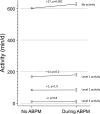The effect of measuring ambulatory blood pressure on nighttime sleep and daytime activity--implications for dipping
- PMID: 20019118
- PMCID: PMC2827604
- DOI: 10.2215/CJN.07011009
The effect of measuring ambulatory blood pressure on nighttime sleep and daytime activity--implications for dipping
Abstract
Background and objectives: Ambulatory blood pressure (BP) monitoring is commonly used to assess the circadian pattern of BP. Circadian BP pattern is influenced by physical activity and sleep cycle. The effect of BP monitoring itself on the level of physical activity and sleep remains unknown. If BP monitoring affects these parameters, then monitoring itself may influence the circadian BP pattern.
Design, setting, participants, & measurements: To assess the effect of ambulatory BP monitoring on sleep duration, sleep efficiency, and daytime activity, we measured physical activity using wrist actigraphy in 103 veterans with chronic kidney disease. After 6 to 7 days of continuous activity monitoring, participants underwent ambulatory BP monitoring with simultaneous actigraphy. The above experiment was repeated after 1 mo.
Results: Among the top tertile of patients (most sleep), when wearing ambulatory BP patients spent less time in bed at night (-92 min, P < 0.0001), were less asleep during those hours (-98 min, P < 0.0001), and had reduced sleep efficiency (82% versus 77%, -5% P = 0.02). On the day of ambulatory BP monitoring, patients were more sedentary during waking hours (+27 minutes, P = 0.002). During ambulatory BP monitoring, waking after sleep onset more than median was associated with greater odds for nondipping (odds ratio 10.5, P = 0.008).
Conclusions: Ambulatory BP monitoring is associated with disturbed sleep and reduced physical activity, characteristics that influence dipping. Ambulatory BP monitoring may itself induce nondipping and may thus mitigate the prognostic significance of the dipping phenomenon.
Figures


Similar articles
-
Ambulatory blood pressure monitoring: importance of sampling rate and duration--48 versus 24 hours--on the accurate assessment of cardiovascular risk.Chronobiol Int. 2013 Mar;30(1-2):55-67. doi: 10.3109/07420528.2012.701457. Epub 2012 Oct 19. Chronobiol Int. 2013. PMID: 23077972 Clinical Trial.
-
Blunted sleep-time relative blood pressure decline increases cardiovascular risk independent of blood pressure level--the "normotensive non-dipper" paradox.Chronobiol Int. 2013 Mar;30(1-2):87-98. doi: 10.3109/07420528.2012.701127. Epub 2012 Oct 5. Chronobiol Int. 2013. PMID: 23039824 Clinical Trial.
-
Agreement Between Ambulatory and Home Blood Pressure Monitoring in Detecting Nighttime Hypertension and Nondipping Patterns in the General Population.Am J Hypertens. 2019 Jul 17;32(8):734-741. doi: 10.1093/ajh/hpz062. Am J Hypertens. 2019. PMID: 31028705
-
Sleep Duration and Blood Pressure: Recent Advances and Future Directions.Curr Hypertens Rep. 2019 Apr 5;21(5):33. doi: 10.1007/s11906-019-0938-7. Curr Hypertens Rep. 2019. PMID: 30953237 Free PMC article. Review.
-
Sleep-time blood pressure: Unique sensitive prognostic marker of vascular risk and therapeutic target for prevention.Sleep Med Rev. 2017 Jun;33:17-27. doi: 10.1016/j.smrv.2016.04.001. Epub 2016 Apr 14. Sleep Med Rev. 2017. PMID: 27316324 Review.
Cited by
-
Primary hypertension and special aspects of hypertension in older children and adolescents.Adolesc Health Med Ther. 2011 Jul 28;2:45-62. doi: 10.2147/AHMT.S11715. eCollection 2011. Adolesc Health Med Ther. 2011. PMID: 24600275 Free PMC article. Review.
-
Clinical and life style factors related to the nighttime blood pressure, nighttime dipping and their phenotypes in Korean hypertensive patients.Clin Hypertens. 2023 Aug 1;29(1):21. doi: 10.1186/s40885-023-00241-w. Clin Hypertens. 2023. PMID: 37525293 Free PMC article.
-
Advances in understanding the peripheral circadian clocks.FASEB J. 2012 Sep;26(9):3602-13. doi: 10.1096/fj.12-203554. Epub 2012 Jun 1. FASEB J. 2012. PMID: 22661008 Free PMC article. Review.
-
Profile of interdialytic ambulatory blood pressure in a cohort of Chinese patients.J Hum Hypertens. 2014 Nov;28(11):677-83. doi: 10.1038/jhh.2014.41. Epub 2014 Jun 12. J Hum Hypertens. 2014. PMID: 24919753
-
Inhibition of αENaC expression and ENaC activity following blockade of the circadian clock-regulatory kinases CK1δ/ε.Am J Physiol Renal Physiol. 2012 Oct;303(7):F918-27. doi: 10.1152/ajprenal.00678.2011. Epub 2012 Jul 25. Am J Physiol Renal Physiol. 2012. PMID: 22832921 Free PMC article.
References
-
- Muxfeldt ES, Cardoso CR, Salles GF: Prognostic value of nocturnal blood pressure reduction in resistant hypertension. Arch Intern Med 169: 874–880, 2009 - PubMed
-
- Agarwal R, Peixoto AJ, Santos SF, Zoccali C: Out-of-office blood pressure monitoring in chronic kidney disease. Blood Press Monit 14: 2–11, 2009 - PubMed
-
- Verdecchia P, Schillaci G, Guerrieri M, Gatteschi C, Benemio G, Boldrini F, Porcellati C: Circadian blood pressure changes and left ventricular hypertrophy in essential hypertension. Circulation 81: 528–536, 1990 - PubMed
-
- Verdecchia P, Angeli F, Cavallini C: Ambulatory blood pressure for cardiovascular risk stratification. Circulation 115: 2091–2093, 2007 - PubMed
Publication types
MeSH terms
LinkOut - more resources
Full Text Sources
Medical

